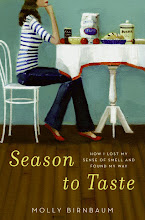
My plane landed in Paris early on a recent Friday morning. Matt, who I last saw over three months ago in California, met me outside of baggage claim. He looked different, yet utterly the same. We rode the train into the city, dropped off my bags, and paused for breakfast at a nearby patisserie. The espresso was thick and nutty; the croissant was buttery and flaked with almonds. Women in heels and men in thin-legged pants walked down the sidewalk on their way to work. The street smelled of cigarette smoke, of coffee and baguettes, of the rotisserie chickens spinning outside of a butcher shop nearby.
I spent ten days in Europe. Matt and I walked all over Paris—exploring the Marais, fighting crowds in the Louvre, tasting coconut macaroons near the Pompidou. We drove to Germany, in a spunky little car that struggled to keep up with the BMWs and Porsches flying down the Autobahn, and stayed for most of the week on the cobble-stoned streets of Bamberg, a medieval town where Matt once lived.
The timing of the trip was perfect. Fall was just beginning and the air was often crisp, the light sharp. There were picnics in parks and walks along rivers. There was the scent of bakeries and chimneys, of smoke and water.
It was also perfect because I needed a break from reality. The financial struggle gripping much of the U.S. has long been biting at the heels of print journalism and, therefore, I recently encountered my first lay-off. In the face of unemployment and an uncertain future, baguettes brought straight from the oven have never tasted so fresh.
In Germany, Matt and I ate in local breweries every night, where thick glass mugs of beer were plunked down before us on the communal wooden tables. There was bratwurst, sauerkraut, and brown bread. There were even sightings of lederhosen and felt caps.
One evening we went to Brauerei Hoh, a small pub tucked in a hamlet near Bamberg. We sat at a table near the back of the main room, warm and filled with people, drinking a fizz-less brew available nowhere but there. We ate pfefferhahnchen, an impossibly delicious half-chicken with skin that was crisp and tender and covered in a bronzed mix of pepper and spice.
“How is this so good?” I asked.
“It’s the best,” Matt said.
That soon became the mantra of our time in Bavaria. It’s the best, said Matt, at least once every day.
Sometimes it was the perfect sweet-sour twang of sauerkraut; sometimes it was the smoke, cascading from a chimney at sunset. Mainly, though, it was the beer. I haven’t always been a fan of beer. I’ve often found it tasteless, needlessly filling. But this beer was different. It changed with each brewery—from flat and tangy to smoked and hammy. But no matter what, each had a depth of flavor I hadn’t realized was possible.
And every night we would sit, order (zwei bier, bitte!), and take a sip. “This is the best,” Matt would say. I would nod. It was.
Until the next night, of course, when that was the best.







